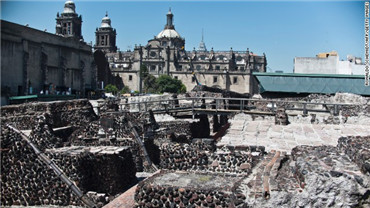
4. The city was built on a lake
這座城市曾經(jīng)建造在一個(gè)湖泊上
It's hard to imagine now, but much of thesprawling concrete jungle that now makes up Mexico City was once a large lake. The Aztecs constructed a massivecivilization there, with Tenochtitlanserving as the capital. That city, which started out on an islandand expanded to include reclaimed parts of the lake, thrived until the Spanishconquest. After winning the battle for control of the area in 1521, Spaniardsdestroyed Tenochtitlan and built Mexico City on top of itsruins, using canals and roads from the Aztec city as the basis for newstreets and eventually draining the lake. But they didn't entirely erase the past.That's made for some fascinating ancient finds as Mexico City grew into a modern urbanmetropolis. In 1978, electrical company workers diggingnear the city's central square came upon an Aztec relic. That led toarchaeologists unearthing ruins of the Templo Mayor, an Aztec temple that's nowa popular tourist destination in Mexico City.
現(xiàn)在很難想象,現(xiàn)在的墨西哥城在從前有很大一部分都是湖泊。阿芝特克人曾在這里建造了一個(gè)文明社會(huì),首都定在特諾奇諦特蘭城。那座城市首先是從一座島嶼開始發(fā)展開來的,后來填埋了部分湖泊,城市得到擴(kuò)張,一直繁榮昌盛,直到西班牙人入侵。在1521年贏得戰(zhàn)爭控制該地區(qū)后,西班牙人摧毀了特諾奇諦特蘭城,并在廢墟之上建立了墨西哥城,以原先運(yùn)河和道路為基礎(chǔ),西班牙重新建造了新街道,并最終抽干了這個(gè)湖泊。但他們并沒有完全抹除過去。隨著后來墨西哥城成為現(xiàn)代化的大都市,那些古老的建筑成了一大亮點(diǎn)。1978年,電力公司的工人在城市中心的廣場挖掘時(shí)發(fā)現(xiàn)了一個(gè)阿芝特克遺跡。這就是阿芝特克大廟的廢墟,現(xiàn)在已經(jīng)成為墨西哥城的一處熱門旅游景點(diǎn)。











